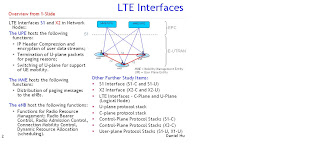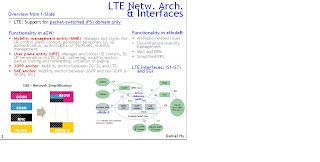LTE Interfaces – S1 and X2 in U-Plane/C-Plane (Daniel Hu Study Note)+(1-Slide).jpg) LTE Interfaces S1 and X2 in Network Nodes:
LTE Interfaces S1 and X2 in Network Nodes:
1). The UPE hosts the following functions:
- IP Header Compression and encryption of user data streams;
- Termination of U-plane packets for paging reasons;
- Switching of U-plane for support of UE mobility.
2). The MME hosts the following functions: - Distribution of paging messages to the eNBs.
3). The eNB host the following functions: - Functions for Radio Resource Management: Radio Bearer Control, Radio Admission Control, Connection Mobility Control, Dynamic Resource Allocation (scheduling).
On the control plane/user plane separation, we have been instrumental in securing the separation of the MME and the SGW. This will allow for
- independent scaling of the MME based on the number of sessions, and
- independent scaling of the SGW based on the volume of traffic.
- We can also optimize the placement of each of these entities in the network if they are separate and enable one-to-many relationship between MME and serving gateway (S-GW).
S1 Interface (S1-C and S1-U) The S1 interface is the interface that separate E-UTRAN and EPC. The S1 interface consists of two parts:
- C-plane (Control): S1-C is the interface between eNB and MME function in EPC.
- U-plane (User): S1-U is the interface between eNB and UPE function in EPC.
- The S1 interface shall be specified so that there is a many-to-many relation between aGWs and eNBs.
The protocols over Uu and S1 interfaces are divided into two structures and those interfaces that linked together provide this E-RAB service :
- User plane protocolsThese are the protocols implementing the actual E-RAB service, i.e. carrying user data through the access stratum.
- Control plane protocolsThese are the protocols for controlling the E-RABs and the connection between the UE and the network from different aspects (including requesting the service, controlling different transmission resources, handover etc.). Also a mechanism for transparent transfer of NAS messages is included
S1AP interface protocol structure: (on C-P)- The radio network (layer) signalling over S1 consists of the S1 Application Part (S1AP over the Transport Network Layer is based on IP transport, comprising SCTP on top of IP.)
- The S1AP protocol consists of mechanisms to handle all procedures between the EPC and E-UTRAN.
- It is also capable of conveying messages transparently between the EPC and the UE without interpretation or processing by the E-UTRAN.
Over the S1 interface the S1AP protocol is, e.g., used to:
*1 Facilitate a set of general E-UTRAN procedures from the EPC such as paging-notification as defined by the notification SAP.
*2 Separate each User Equipment (UE) on the protocol level for mobile specific signalling management as defined by the dedicated SAP.
*3 Transfer of transparent non-access signalling as defined in the dedicated SAP.
*4 Request of various types of E-RABs through the dedicated SAP.
*5 Perform the mobility function.
S1-U interface protocol: (on U-P)- The S1 user plane interface (S1-U) is defined between the eNB and the S-GW.
- The S1-U interface provides non guaranteed delivery of user plane PDUs between the eNB and the S-GW.
- The transport network layer is built on IP transport and GTP-U is used on top of UDP/IP to carry the user plane PDUs between the eNB and the S-GW.
The S1-U interface supports the tunnelling of end user packets between the eNB and the UPE. The tunnelling protocols support the following functions:
- Indication of the SAE Access Bearer in the target node that the packet belongs to.
- Means to minimize packet losses due to mobility.
- Packet loss detection mechanism
- Error handling mechanism
- MBMS support functions
X2 Interface (X2-C and X2-U)The X2 interface is the interface between eNBs. The X2 interface consists of two parts:
- C-plane (Control): X2-C is the C-plane interface between eNBs.
- U-plane (User): X2-U is the U-lane interface between eNBs
The X2 interface specifications shall facilitate the following:
- inter-connection of eNBs supplied by different manufacturers;
- support of continuation between eNBs of the E-UTRAN services offered via the S1 interface;
- separation of X2 interface Radio Network functionality and Transport Network functionality to facilitate introduction of future technology.
X2AP interface protocol structure- The application layer signalling protocol is referred to as X2AP (X2 Application Protocol).
- The transport network layer is built on SCTP on top of IP.
- There shall exist a clear separation between the Radio Network Layer and the Transport Layer. Therefore, the radio network signaling and X2 data streams are separated from the data transport resource and traffic handling
X2-U interface protocol: (on U-P)- The X2-UP interface protocol stack is identical to the S1-UP protocol stack.
- X2 User plane protocol: Tunnelling protocol GTP-U
- The transport network layer is built on IP transport and GTP-U is used on top of UDP/IP to carry the user plane PDUs.
The X2-U interface supports the tunneling of end user packets between the eNBs. The tunneling protocols support the following functions:
- Indication of the SAE Access Bearer in the target node that the packet belongs to.
- Means to minimize packet losses due to mobility.
Further Information:
+1st-Slide.jpg)
+2nd-Slide.jpg)
.jpg)
+(1-Slide).jpg)
.jpg)
.jpg)
.jpg)
.jpg)